Showing 1–20 of 68 resultsSorted by latest
-
Sale!
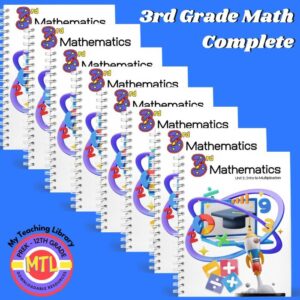 Buy Now
Buy Now$40.50Original price was: $40.50.$35.00Current price is: $35.00.3rd Grade Math Complete is an 8 unit program that covers all of the important skills and concepts typically covered in 3rd grade. Each unit includes the student and teacher edition. This resource can be used within a classroom setting, co-op or with individual students. Because it can be used within a group setting, you’ll find many activities for students to complete in pairs of 2. If you are homeschooling multiple children close in age, it would be easy to adapt and teach students together. If you are homeschooling a single child, you can easily adapt these activities through your one-on-one interaction!
You do not need to use the entire program if you are only wanting to focus on one or a few specific Math skills and concepts. If this is the case, you can purchase each unit separately.
Units:
- – Unit 1: Intro to Multiplication
- – Unit 2: Geometry: Area, Arrays and Multiplication
- – Unit 3: Reviewing Addition & Subtraction within 1,000
- – Unit 4: Relating Multiplication and Division
- – Unit 5: Fractions – Number Lines, Equivalent & Comparing
- – Unit 6: Measurement – Length, Time, Volume & Weight
- – Unit 7: Geometry – 2 Dimensional Shapes, Area & Perimeter
- – Unit 8: Review of 3rd Grade Skills & Concepts
-
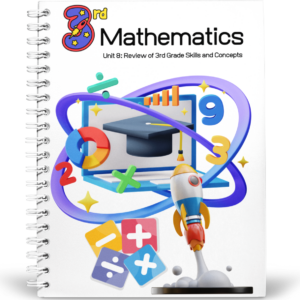 $5.00Buy Now
$5.00Buy NowIn this unit, students revisit major work and fluency of 3rd grade math skills and concepts including comparing, adding, and subtracting fractions, multiplying and dividing within 1,000, and using the standard algorithm to add and subtract multi-digit numbers.
Includes: Student and Teacher Editions
Size: 256 pages -
 $5.00Buy Now
$5.00Buy NowIn this unit, students will learn about fractions, naming parts, building from units, locating on a number line, equivalent fractions, and how to compare fractions with the same denominator and the same numerator.
Includes: Student and Teacher Editions
Size: 338 pages -
 $6.00Buy Now
$6.00Buy NowThis unit introduces students to the concept of division and its relationship to multiplication. Previously, students learned that multiplication can be understood in terms of equal-size groups. The expression 5 x 2 can represent the total number of objects when there are 5 groups of 2 objects, or when there are 2 groups of 5 objects. Here, students make sense of division also in terms of equal-size groups. For instance, the expression 30 ÷ 5 can represent putting 30 objects into 5 equal groups, or putting 30 objects into groups of 5. They see that, in general, dividing can mean finding the size of each group, or finding the number of equal groups. Students use the relationship between multiplication and division to develop fluency with single-digit multiplication and division facts. They continue to reason about products of two numbers in terms of the area of rectangles whose side lengths represent the factors, decomposing side lengths and applying properties of operations along the way. As they multiply numbers greater than 10, students see that it is helpful to decompose the two-digit factor into tens and ones and distribute the multiplication. Toward the end of the unit, students solve two-step problems that involve all four operations.
Includes: Student and Teacher Editions
Size: 431 pages -
 $5.00Buy Now
$5.00Buy NowIn this unit, students work toward the goal of fluently adding and subtracting within 1,000. They use mental math strategies developed in grade 2 and learn algorithms based on place value. Students work with a variety of algorithms, starting with those that show expanded form, and moving toward algorithms that are more streamlined and closer to the standard algorithm. Understanding of place value also comes into play as students round numbers to the nearest multiple of 10 and 100. Students do not need to know a formal definition of “multiples” until grade 4. At this point, it is enough to recognize that a multiple of 10 is a number called out when counting by 10, or the total in a whole-number of tens (such as 8 tens). Likewise, a multiple of 100 is a number called out when counting by 100, or the total in a whole-number of hundreds (such as 6 hundreds). Students use rounding to estimate answers to two-step problems and determine if answers are reasonable.
Includes: Student and Teacher Editions
Size: 374 pages -
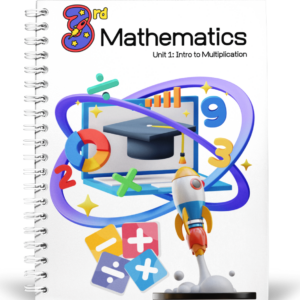 $5.00Buy Now
$5.00Buy NowIn this unit, students ready to learn multiplication will interpret and represent data on scaled picture graphs and scaled bar graphs and then they will learn the concept of multiplication! Students explore scaled picture graphs and bar graphs as an entry point for learning about equal-size groups and multiplication. The idea that one picture can represent multiple objects helps to introduce the idea of equal-size groups. Students learn that multiplication can mean finding the total number of objects in groups of objects each, and can be represented by a x b. They then relate the idea of equal groups and the expression a x b to the rows and columns of an array. In working with arrays, students begin to notice the commutative property of multiplication. In all cases, students make sense of the meaning of multiplication expressions before finding their value, and before writing equations that relate two factors and a product. Later in the unit, students see situations in which the total number of objects is known but either the number of groups or the size of each group is not known. Problems with a missing factor offer students a preview to division.
Includes: Student and Teacher Editions
Size: 369 pages -
Sale!
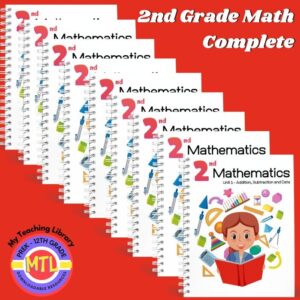 Buy Now
Buy Now$45.00Original price was: $45.00.$35.00Current price is: $35.00.2nd Grade Math Complete is a 9 unit program that covers all of the important skills and concepts typically covered in 2nd grade. Each unit includes the student and teacher edition. This resource can be used within a classroom setting, co-op or with individual students. Because it can be used within a group setting, you’ll find many activities for students to complete in pairs of 2. If you are homeschooling multiple children close in age, it would be easy to adapt and teach students together. If you are homeschooling a single child, you can easily adapt these activities through your one-on-one interaction!
You do not need to use the entire program if you are only wanting to focus on one or a few specific Math skills and concepts. If this is the case, you can purchase each unit separately.
Units:
- – Unit 1: Adding & Subtracting + Working with Data
- – Unit 2: Adding & Subtracting within 100
- – Unit 3: Measuring (Length)
- – Unit 4: Working with Number Lines
- – Unit 5: Working with Numbers to 1,000
- – Unit 6: Shapes, Time and Money
- – Unit 7: Adding & Subtracting to 1,000
- – Unit 8: Arrays: Even/Odd, Geometry & Multiplication Readiness
- – Unit 9: Review: 2nd Grade Level Skills & Concepts
-
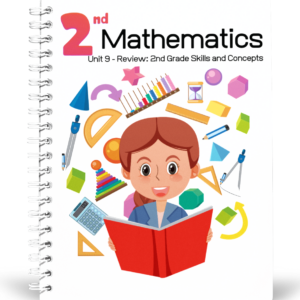 $4.50Buy Now
$4.50Buy NowIn this unit, students revisit major work and fluency goals of the grade, applying their learning from the year. Section A gives students a chance to solidify their fluency with addition and subtraction within 20. In section B, students apply methods they used with smaller numbers to add and subtract numbers within 100. In the final section, students interpret, solve, and write story problems involving numbers within 100, which further develop their fluency with addition and subtraction of two-digit numbers. They work with all problem types with the unknown in all positions.
Includes: Student and Teacher Editions
Size: 233 pages -
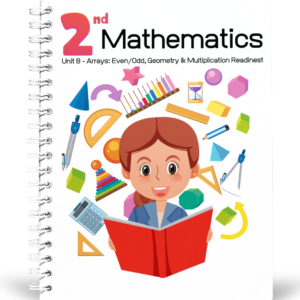 $5.00Buy Now
$5.00Buy NowIn this unit, students develop an understanding of equal groups, building on their experiences with skip-counting and with finding the sums of equal addends. The work here serves as the foundation for multiplication and division in grade 3 and beyond. Students begin by analyzing even and odd numbers of objects. They learn that any even number can be split into 2 equal groups or into groups of 2, with no objects left over. Students use visual patterns to identify whether numbers of objects are even or odd. Next, students learn about rectangular arrays. They describe arrays using mathematical terms (rows and columns). Students see the total number of objects as a sum of the objects in each row and as a sum of the objects in each column, which they express by writing equations with equal addends. They also recognize that there are many ways of seeing the equal groups in an array. Later, students transition from working with arrays containing discrete objects to equal-size squares within a rectangle. They build rectangular arrays using inch tiles and partition rectangles into rows and columns of equal-size squares. The work here sets the stage for the concept of area in grade 3.
Includes: Student and Teacher Editions
Size: 263 -
 $5.00Buy Now
$5.00Buy NowIn this unit, students extend their knowledge of the units in the base-ten system to include hundreds. They learn that a hundred is a unit made up of 10 tens, and three-digit numbers are formed using units of hundreds, tens, and ones. To make sense of numbers in different ways and to build flexibility in reasoning with them, students work with a variety of representations: base-ten blocks, base-ten diagrams or drawings, number lines, expressions, and equations. At the start of the unit, students express a quantity in terms of the number of units represented by base-ten blocks. Next, students make sense of three-digit numbers on the number line.
Includes: Student and Teacher Editions
Size: 287 -
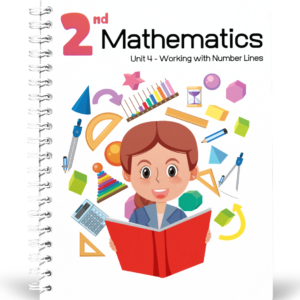 $5.00Buy Now
$5.00Buy NowIn this unit, students are introduced to the number line, an essential representation that will be used throughout students’ K–12 mathematical experience. They learn to use the number line to represent whole numbers, sums, and differences. They see that the tick marks and numbers on the number line are like those on a ruler: both show equally spaced numbers that represent lengths from 0. Students use this understanding of structure to locate and compare numbers on the number line, as well as to estimate numbers represented by points on the number line. Students then learn conventions for representing addition and subtraction on the number line: using arrows pointing to the right for adding and arrows pointing to the left for subtracting. Students also use the number line to represent addition and subtraction methods discussed in Number Talks, such as counting on, counting back by place, and decomposing a number to get to a ten. The reasoning here deepens students’ understanding of the relationship between addition and subtraction.
Includes: Student and Teacher Editions
Size: 309 -
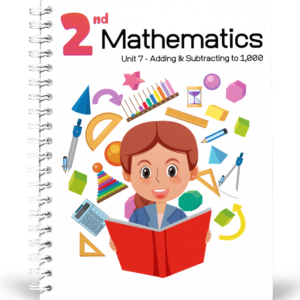 $5.00Buy Now
$5.00Buy NowIn this unit, students add and subtract within 1,000, with and without composing and decomposing a base-ten unit. They apply the methods they know and their understanding of place value and three-digit numbers to find sums and differences within 1,000. Initially, students add and subtract without composing or decomposing a ten or hundred. Instead, they rely on methods based on the relationship between addition and subtraction and the properties of operations. They make sense of sums and differences using counting sequences, number relationships, and representations (number line, base-ten blocks, base-ten diagrams, and equations). As the unit progresses, students work with numbers that prompt them to compose and decompose one or more units, eliciting strategies based on place value. Students learn to recognize when composition or decomposition is a useful strategy when adding or subtracting by place. In the later half of the unit, they encounter lessons that encourage them to think flexibly and use strategies that make sense to them based on number relationships, properties of operations, and the relationship between addition and subtraction.
Includes: Student and Teacher Editions
Size: 396 -
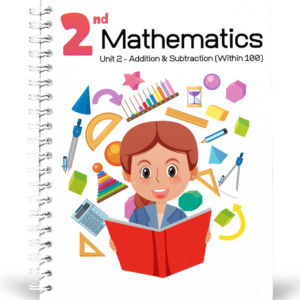 $5.00Buy Now
$5.00Buy NowIn this unit, students add and subtract within 100 using strategies based on place value, the properties of operations, and the relationship between addition and subtraction. Students begin by using any strategy to find the value of sums and differences that do not involve composing or decomposing a ten. They are then introduced to base-ten blocks as a tool to represent addition and subtraction and move towards strategies that involve composing and decomposing tens. Students develop their understanding of grouping by place value, and begin to subtract one- and two-digit numbers from two-digit numbers by decomposing a ten as needed. They apply properties of operations and practice reasoning flexibly as they arrange numbers to facilitate addition or subtraction. At the end of the unit, students apply their knowledge of addition and subtraction within 100 to solve one- and two-step story problems of all types, with unknowns in all positions. To support them in reasoning about place value when adding and subtracting, students may choose to use connecting cubes, base-ten blocks, tape diagrams, and other representations learned in earlier units and grades.
Includes: Student and Teacher Editions
Size: 336 pages -
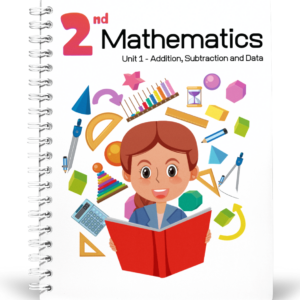 $5.00Buy Now
$5.00Buy NowIn this unit, students begin to develop (or review) fluency with sums and differences within 20, building on concepts of addition and subtraction that they covered while covering 1st grade skills and concepts. They learn new ways to represent and solve problems involving addition, subtraction, and categorical data. Students are introduced to picture graphs and bar graphs as a way to represent categorical data. They ask and answer questions about situations described by the data. The structure of the bar graphs paves the way for a new representation, the tape diagram. Students learn that tape diagrams can be used to represent and make sense of problems involving the comparison of two quantities. The diagrams also help to deepen students’ understanding of the relationship between addition and subtraction.
Includes: Student and Teacher Editions
Size: 376 pages -
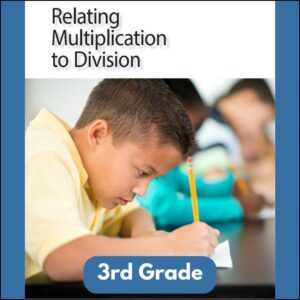 $2.00Buy Now
$2.00Buy NowThis unit introduces students to the concept of division and its relationship to multiplication. Previously, students learned that multiplication can be understood in terms of equal-size groups. The expression 5 x 2 can represent the total number of objects when there are 5 groups of 2 objects, or when there are 2 groups of 5 objects. Here, students make sense of division also in terms of equal-size groups. For instance, the expression 30 ÷ 5 can represent putting 30 objects into 5 equal groups or putting 30 objects into groups of 5. They see that, in general, dividing can mean finding the size of each group, or finding the number of equal groups. Students use the relationship between multiplication and division to develop fluency with single-digit multiplication and division facts.
This resource includes both student and teacher materials.
Number of Lessons: 21 and 1 optional
Lesson Time: Approximately 60 minutes. Please note that each lesson is designed for one instructional block and may be divided into shorter or longer segments based on teacher pacing and student needs.
-
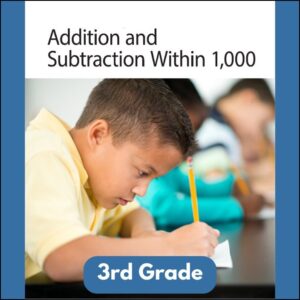 $2.00Buy Now
$2.00Buy NowIn this unit, student work toward the goal of fluently adding and subtracting within 1,000. They will use mental strategies as well as learn algorithms based on place value. By the end of this unit, students will also use rounding to estimate answers to two-step problems and determine if answers are reasonable.
This resource includes both student and teacher materials.
Number of Lessons: 20 and 1 optional
Lesson Time: Approximately 60 minutes. Please note that each lesson is designed for one instructional block, and may be divided into shorter or longer segments based on teacher pacing and student needs.See description below for more details.
-
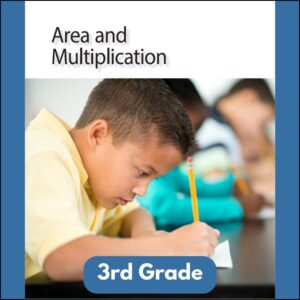 $2.00Buy Now
$2.00Buy NowThis unit is designed to build on unit 1 as student explore the concept of area and relate the area of rectangles to multiplication as well as solving area problems. Students also learn some standard unit of area such as square inches, square centimeters, square feet and square meters as they solve real-world problems! By the end of the unit, students find the area and missing side lengths of figures composed on non-overlapping rectangles.
This resource includes both student and teacher materials.
Number of Lessons: 13 and 2 optional
Lesson Time: Approximately 60 minutes. Please note that each lesson is designed for one instructional block, and may be divided into shorter or longer segments based on teacher pacing and student needs.
View a short preview video hereSee description below for more details.
-
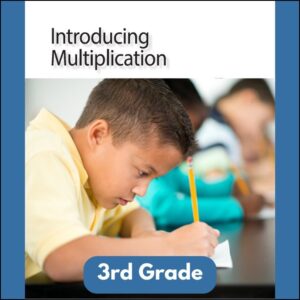 $2.00Buy Now
$2.00Buy NowThis unit is designed to help students learn multiplication by gaining an understanding through the use of picture and bar graphs. Material is presented so that students learn multiplication means finding the total number of objects in groups of objects and can be represented by a x b. Students will work with arrays to learn and understand multiplication expressions before beginning to write the equations. By the end of the unit, problems with a missing factor offers the student a preview to division.
This resource includes both student and teacher materials.
Number of Lessons: 20 and 1 optional
Lesson Time: Approximately 60 minutes. Please note that each lesson is designed for one instructional block, and may be divided into shorter or longer segments based on teacher pacing and student needs.
View a short preview video hereSee description below for more details.
-
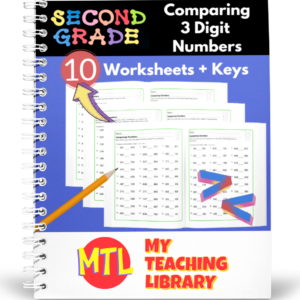 $1.75Buy Now
$1.75Buy NowThis set of no prep, 10 worksheets will give students the practice they need to compare three digit numbers. Students will be asked to use greater than, less than or an equal sign (<, > or =) for each pair of numbers. Each worksheet includes 30 number pairs to compare. Answer keys are included.
-
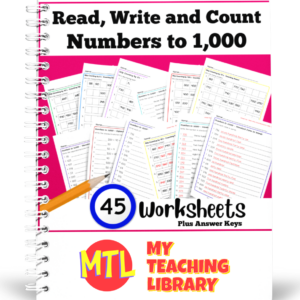 $3.50Buy Now
$3.50Buy NowThis resource will give students the opportunity to:
- – Display their understanding that the three digits of a three-digit number represent amounts of hundreds, tens, and ones; e.g., 706 equals 7 hundreds, 0 tens, and 6 ones by converting numbers to expanded form as well as full expanded form (numbers to 1000)
- – Show their ability to skip count by 5s, 10s, and 100s (numbers to 1000)
- – Read and write numbers to 1000 using base-ten numerals, number names, expanded form and full expanded form
This resource includes 45 worksheets plus answer keys:
- 5 Worksheets by 5s – Counting up
- 5 Worksheets by 5s – Counting down
- 5 Worksheets by 10s – Counting up
- 5 Worksheets by 10s – Counting down
- 3 Worksheets by 100s – Counting up
- 2 Worksheets by 100s – Counting both up and down
- 5 Worksheets – Given words to covert to standard form
- 5 Worksheets – Given standard form to covert to words
- 5 Worksheets – Given expanded form to covert to standard
- 5 Worksheets – Given standard form to convert to full expanded notation

